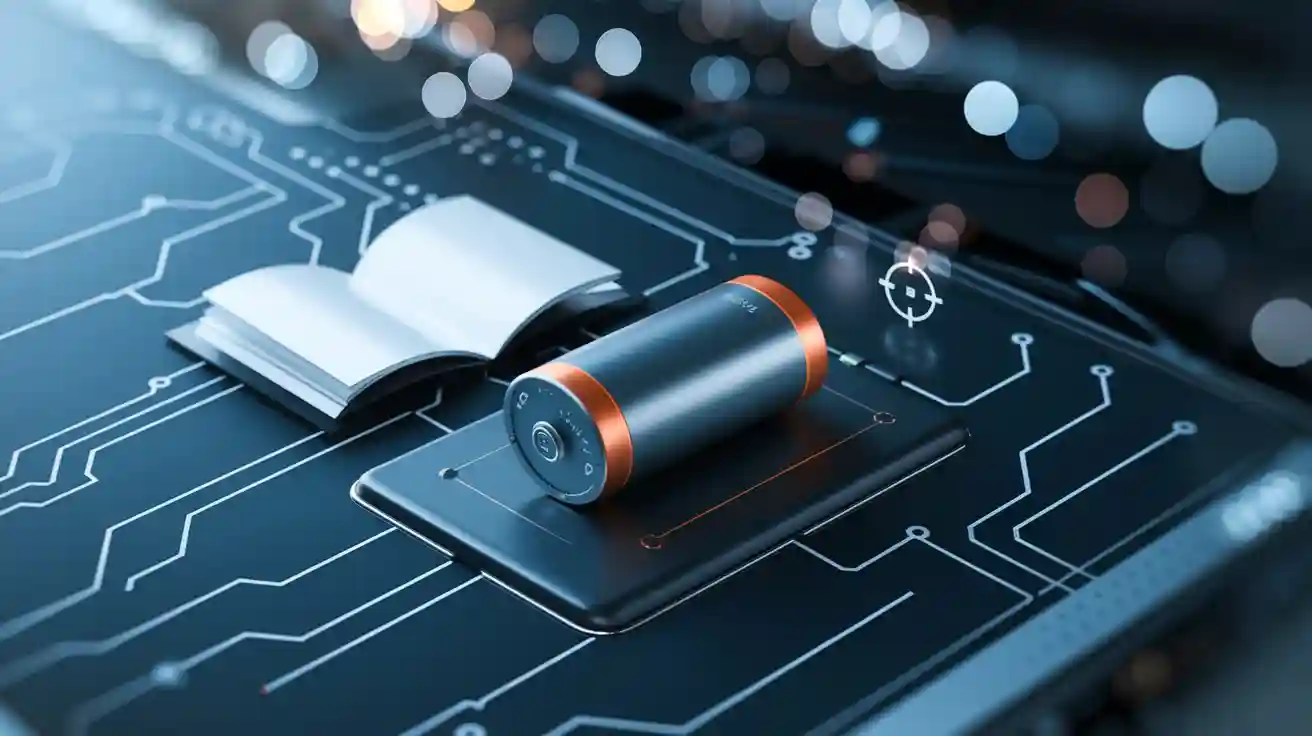
Imagine reaching for a smartphone or driving an electric car, both powered by advanced battery technology. Ternary lithium batteries play a key role in these devices, offering high energy density and reliable performance. Many modern electric vehicles and portable electronics rely on these batteries for longer usage and better capacity. As the global demand for efficient battery solutions grows, especially in the automotive sector, people need to understand the differences between battery types. Curiosity about how ternary lithium batteries compare to other options helps consumers make smart choices.
What Are Ternary Lithium Batteries?
Определение
Ternary lithium batteries are a type of rechargeable battery that use three different metals in the cathode. These batteries belong to the lithium-ion battery family. They have become important in modern technology because they offer high energy density, good cycle life, and reliable performance. Industry standards define a ternary lithium battery by its nominal voltage of about 3.7V and a working voltage range from 3.6V to 4.3V. The energy density usually falls between 170 and 200Wh/kg or higher. Most ternary lithium batteries can last for about 800 charge and discharge cycles under normal conditions.
The battery works by moving lithium ions back and forth between the cathode and the anode during charging and discharging. The cathode contains a mix of nickel, cobalt, and manganese. The anode usually uses graphite. This movement of lithium ions creates an electric current, which powers devices like electric vehicles and smartphones. Ternary lithium batteries use advanced techniques to combine the three metals into a stable, layered structure. This structure helps balance energy density, safety, and cost.
Note: Ternary lithium batteries include built-in protection features. These features prevent overcharging and over-discharging, which helps keep the battery safe and long-lasting.
Why “Ternary”?
The word “ternary” means “three parts.” In ternary lithium batteries, the cathode contains three key metals: nickel, cobalt, and manganese. Each metal plays a special role in how the battery works and performs.
| Metal | Role in Battery Performance |
|---|---|
| Nickel | Increases energy capacity and boosts energy density. It acts as the main element for storing and releasing energy. |
| Cobalt | Stabilizes the layered structure of the cathode. It helps the battery last longer and keeps performance steady over many cycles. |
| Manganese | Improves safety and stability. It lowers the risk of overheating and helps the battery work well at different temperatures. |
Nickel gives the battery more power and storage ability. Cobalt keeps the battery structure strong and helps it last through many charges. Manganese makes the battery safer and less expensive to produce. By combining these three metals, ternary lithium batteries achieve a balance of high energy, safety, and cost-effectiveness. This balance makes them popular in electric vehicles, portable electronics, and other modern devices.
Ternary Lithium Battery Composition
Cathode Materials
The cathode material in a ternary lithium battery uses a mix of nickel, cobalt, and manganese or sometimes aluminum. Each metal in the cathode material has a special job. Nickel increases the energy density, which means the battery can store more power. Cobalt helps keep the layered structure stable and improves how long the battery lasts. Manganese or aluminum adds safety and makes the battery more stable during use.
Changing the ratio of these metals in the cathode material changes how the battery works. More nickel in the cathode material gives higher energy density, but it can lower the battery’s lifespan and make it less stable. More cobalt in the cathode material improves stability and cycle life, but it costs more. Manganese or aluminum in the cathode material helps with safety and keeps the battery strong, but too much can lower the battery’s capacity.
| Cathode Composition | Ni:Co:Mn or Al Ratio | Effect on Energy Density | Effect on Lifespan and Stability | Дополнительные заметки |
|---|---|---|---|---|
| NCM111 | 1:1:1 | Moderate energy density (~160 mAh/g) | High cycle life, excellent structural stability | Balanced performance, used in low-cost EVs and power tools |
| NCM523 | 5:2:3 | Moderate to high energy density | High cycle life, good thermal stability | Higher cobalt content improves stability but increases cost |
| NCM811 | 8:1:1 | Very high energy density (~200 mAh/g) | Lower cycle life (~1000 cycles), poorer thermal stability | High nickel boosts capacity but causes structural instability |
| NCA | 8:1.5:0.5 (Ni:Co:Al) | Very high energy density | Moderate cycle life and thermal stability | Aluminum improves structural reinforcement and safety |
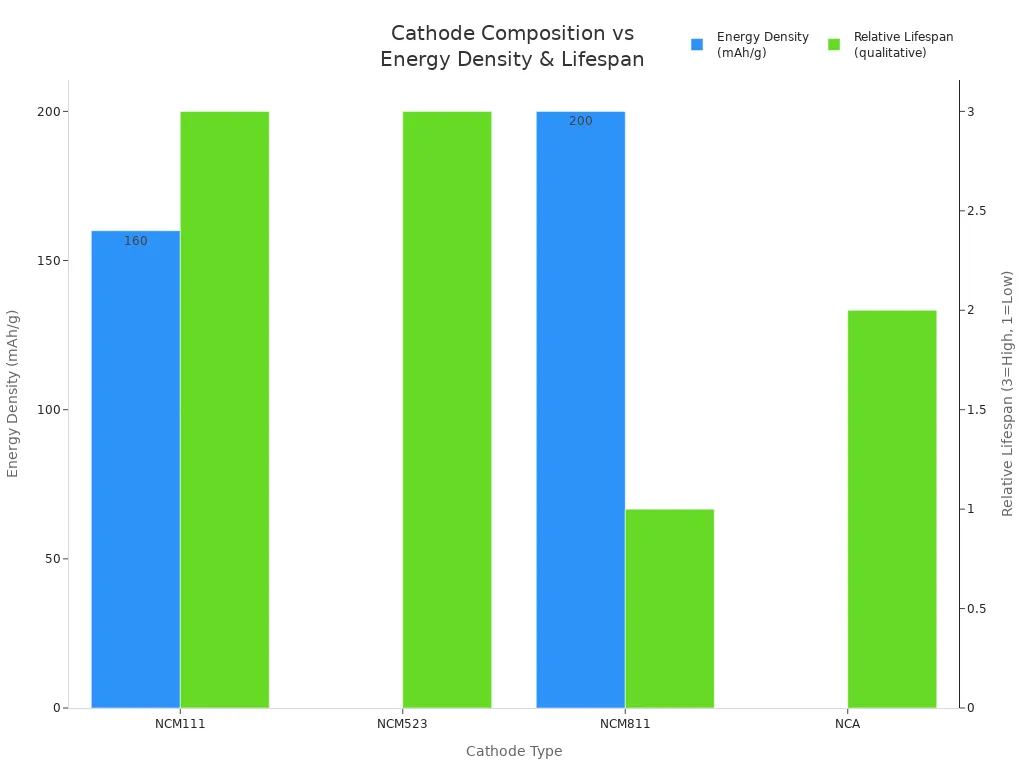
Tip: Battery makers must balance nickel, cobalt, and manganese or aluminum in the cathode material to get the best mix of energy, safety, and lifespan.
Anode and Electrolyte
The anode material in a ternary lithium battery is usually graphite. Graphite lets lithium ions move in and out easily, which helps the battery charge and discharge many times without losing much power. This anode material gives the battery good efficiency and a long cycle life.
The electrolyte in these batteries is often a lithium salt, such as lithium hexafluorophosphate. The electrolyte lets lithium ions travel between the cathode material and the anode material. This movement is key for the battery’s performance and charging speed. The right electrolyte also helps keep the battery safe by lowering the risk of overheating.
| Компонент | Common Materials | Role / Impact on Battery Performance and Safety |
|---|---|---|
| Anode | Графит | Provides stable lithium intercalation, contributing to efficiency and cycle performance. |
| Электролит | Lithium salts (e.g., lithium hexafluorophosphate) | Essential for ionic conductivity, directly affecting battery performance and charging efficiency. |
| Cathode | Ternary compounds: Nickel, Cobalt, Manganese (NCM) or Nickel, Cobalt, Aluminum (NCA) | Nickel: Increases energy density. Cobalt: Stabilizes layered structure, improves conductivity and cycle life. Manganese: Reduces cost, enhances structural stability and safety. Aluminum (in NCA): Replaces manganese, contributing to stability. |
| Безопасность | – | Ternary lithium batteries have lower safety than lithium iron phosphate batteries. Manganese and cobalt improve stability, but risks remain at high temperatures. |
| Efficiency | – | High energy density and charging efficiency due to the combination of ternary cathode material, graphite anode material, and lithium salt electrolyte. |
Ternary lithium batteries use these materials to reach high energy density and good efficiency. The right choice of cathode material and anode material helps these batteries power electric vehicles and electronics for a long time.
How Ternary Lithium Batteries Work
Charge and Discharge Process
A ternary lithium battery stores and releases energy through the movement of lithium ions. When someone charges the battery, lithium ions leave the positive electrode (cathode) and travel through the electrolyte to the negative electrode (anode), which is usually made of graphite. The ions stay in the graphite until the battery gets used. During discharge, the process reverses. Lithium ions move back to the cathode, and this movement creates an electric current that powers devices.
The battery uses a separator to keep the positive and negative electrodes apart. This separator allows only lithium ions to pass through, which helps prevent short circuits. The battery’s design lets it charge quickly and deliver power efficiently. Many electric vehicles and smartphones use this type of battery because it can store a lot of energy in a small space.
Tip: To extend the life of a ternary lithium battery, avoid deep discharges and extreme temperatures.
Chemical Structure
The chemical structure of a ternary lithium battery sets it apart from other lithium-ion batteries. The cathode contains a mix of nickel, cobalt, and manganese or sometimes aluminum. This mix forms compounds like lithium nickel cobalt manganese oxide (NCM) or lithium nickel cobalt aluminum oxide (NCA). The anode is usually graphite, which stores lithium ions during charging.
- Ternary lithium batteries use cathodes made from multiple metal oxides, such as NCM or NCA.
- The ratio of nickel, cobalt, and manganese or aluminum in the cathode can change the battery’s performance.
- The anode in both ternary lithium batteries and other lithium-ion batteries is generally graphite.
- Lithium iron phosphate (LFP) batteries use lithium iron phosphate as the cathode, which is more stable and safer but has lower energy density.
- Ternary lithium batteries offer higher energy density but less stability compared to LFP batteries.
The unique chemical structure of a ternary lithium battery allows it to deliver more energy and power. However, it also means the battery needs careful management to stay safe and last longer.
Performance of Ternary Lithium Batteries
Плотность энергии
Ternary lithium batteries stand out for their high energy density. This means they can store a large amount of energy in a small and lightweight package. Many electric vehicles and portable devices use these batteries because they need long-lasting power without adding much weight. The energy density of a ternary lithium battery usually ranges from 200 to 260 Wh/kg. Some of the best nickel manganese cobalt (NMC) batteries can even reach over 300 Wh/kg. Nickel cobalt aluminum (NCA) batteries, which are also a type of ternary lithium battery, offer around 260 Wh/kg.
The table below compares the energy density of different lithium battery types:
| Химия аккумулятора | Средняя плотность энергии (Втч/кг) |
|---|---|
| Ternary Lithium Batteries | 200 – 260 |
| Литий-железо-фосфат (LFP) | 90 – 160 (up to 205 for next-gen) |
| Nickel Manganese Cobalt (NMC) | Over 300 |
| Nickel Cobalt Aluminum (NCA) | Around 260 |
A higher energy density allows devices to run longer between charges. This feature makes ternary lithium batteries a popular choice for electric cars and high-end electronics. However, higher energy density can sometimes lead to trade-offs in other areas, such as safety and lifespan.
Note: High energy density helps reduce the size and weight of battery packs in electric vehicles, making cars lighter and more efficient.
Цикл жизни
Cycle life measures how many times a battery can charge and discharge before its capacity drops below a certain level, usually 80%. Ternary lithium batteries typically last between 500 and 1,000 cycles under standard conditions. Some advanced models can reach up to 2,300 cycles, but this depends on how the battery is used and managed.
In comparison, lithium iron phosphate (LiFePO4) batteries have a much longer cycle life. They often last between 2,000 and 7,000 cycles, and some can even exceed 10,000 cycles under ideal conditions. LiFePO4 batteries also lose capacity more slowly over time.
| Тип батареи | Cycle Life (at ~80% capacity retention) |
|---|---|
| LiFePO4 | 2,000 – 7,000 cycles |
| Ternary Lithium (NCM) | 500 – 1,000 cycles |
| Lithium-ion Polymer | 300 – 1,000 cycles |
Ternary lithium batteries offer higher energy density but have a shorter cycle life than LiFePO4 batteries. This means they may need replacement sooner, especially in applications that require frequent charging and discharging.
Power Output
Power output describes how quickly a battery can deliver energy. Ternary lithium batteries provide strong power output, which is important for electric vehicles that need quick acceleration or devices that require bursts of energy. In electric vehicle applications, these batteries usually operate at discharge rates from 1C to 3C during normal driving. For short bursts, such as rapid acceleration, they can handle up to a 5C discharge rate for about 30 seconds.
- Typical discharge rates for ternary lithium batteries in electric vehicles: 1C to 3C
- Peak power testing (short bursts): up to 5C for 30 seconds
- High-power batteries in special vehicles can reach 2C to 5C
- Discharge rates above 5C are rare and used only in special cases, like electric aircraft
These high discharge rates allow ternary lithium batteries to deliver strong performance in demanding situations. The ability to provide quick power makes them suitable for cars, power tools, and other high-performance devices.
Temperature Tolerance
Temperature tolerance affects how well a battery works in hot or cold conditions. Ternary lithium batteries can operate at low temperatures, with some advanced models working down to -40°C and retaining about 67% of their discharge capacity. Most standard ternary lithium batteries can function at -20°C with over 50% capacity retention and about 400 cycles of life. Engineers improve low-temperature performance by changing the electrolyte and materials inside the battery.
However, ternary lithium batteries face challenges at high temperatures. The NCM cathode can become unstable, leading to faster degradation and a higher risk of thermal runaway, which is a dangerous overheating event. In contrast, lithium iron phosphate batteries show better thermal stability and safety at high temperatures. They also maintain a longer cycle life and more stable performance in both hot and cold environments.
| Аспект | Ternary Lithium Batteries (NCM-based) | Lithium Iron Phosphate (LFP) Batteries |
|---|---|---|
| High Temperature Performance | Poor thermal stability; risk of rapid degradation and thermal runaway | Better thermal stability; safer at high temperatures |
| Low Temperature Performance | Capacity loss; can discharge down to -40°C (advanced models) | Better cycle life and stability at low temperatures |
| Цикл жизни | Less than 2,000 cycles (e.g., NCM622) | Greater than 4,000 cycles |
| Вопросы безопасности | Повышенный риск теплового выброса | Lower risk of thermal runaway |
Tip: Users should avoid exposing ternary lithium batteries to extreme heat or cold for long periods. Proper temperature management helps maintain battery performance and safety.
Advantages and Disadvantages
Преимущества
Ternary lithium batteries offer several important benefits for modern technology. These batteries provide high energy density, which means they can store a lot of energy in a small and lightweight package. This feature helps electric vehicles travel farther and makes smartphones and laptops thinner and lighter. The current energy density for these batteries is around 232 Wh/kg, and experts expect this number to rise to 293 Wh/kg in the future.
Another key advantage is fast charging. Ternary lithium batteries can handle high charging currents without losing much efficiency. This ability allows users to recharge their devices or vehicles quickly. The table below shows how these batteries maintain a high constant current ratio even at fast charging rates:
| Recharging Current (Ah) | Constant Current Capacity (Ah) | Total Capacity (Ah) | Constant Current Capacity / Total Capacity (%) |
|---|---|---|---|
| 7.50 | 8.21 | 8.62 | 95.24 |
| 37.50 | 7.17 | 8.54 | 84.01 |
| 75.00 | 6.42 | 8.58 | 74.82 |
| 112.50 | 5.65 | 8.60 | 65.71 |
| 150.00 | 4.55 | 8.62 | 52.75 |
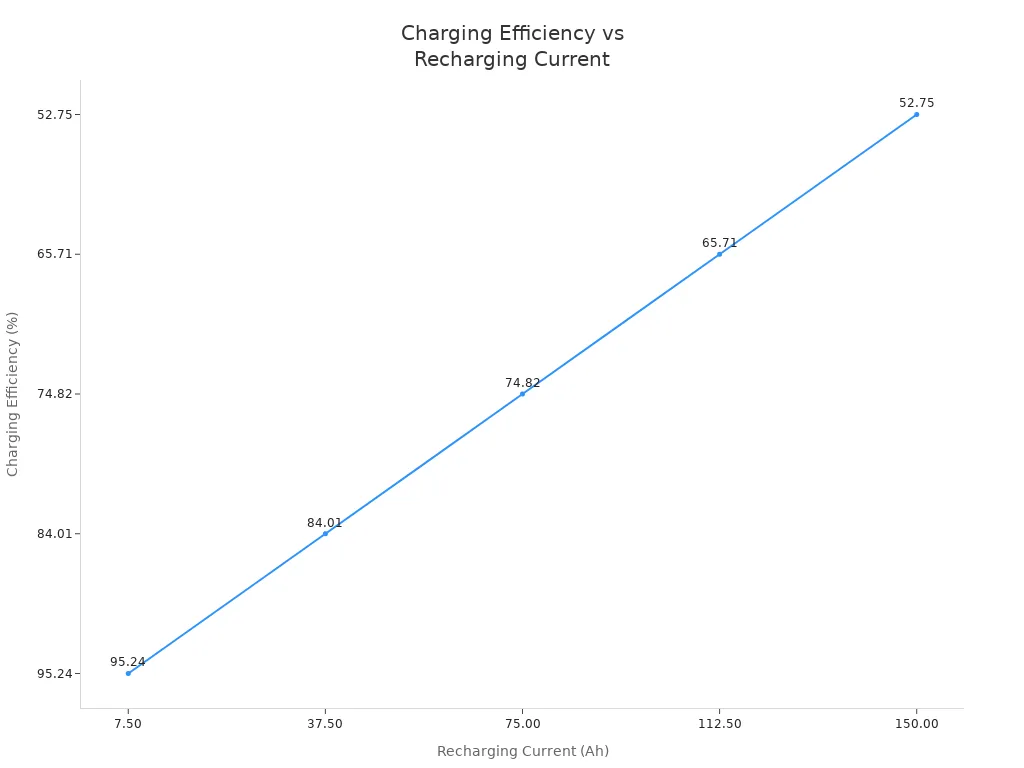
These batteries also save space and weight, which is very important for electric vehicles. High energy density and fast charging make ternary lithium batteries a top choice for many consumer electronics and cars.
Недостатки
Despite their strengths, ternary lithium batteries have some clear disadvantages. The most common problem is their shorter cycle life. Most of these batteries last less than 2,000 cycles, which means they may need replacement sooner than other types. Poor heat resistance is another issue. These batteries can overheat and even catch fire if not managed carefully.
The liquid electrolyte inside the battery is flammable and can cause thermal runaway, which is a dangerous chain reaction. Lithium dendrite growth can also occur, which may pierce the separator and cause short circuits. The cost of raw materials and production is high, making these batteries more expensive.
| Disadvantage / Limitation | Пояснение |
|---|---|
| Poor safety performance | Difficult to pass safety tests, especially for large batteries. |
| Short cycle life | Typical cycle life around 500 cycles; deep discharge damages the battery. |
| High production cost | Expensive raw materials and manufacturing process. |
| Structural degradation | High manganese or nickel content can damage the battery structure. |
| Limited application | Mainly used in consumer electronics, not favored for heavy-duty use. |
Воздействие на окружающую среду is another concern. Producing and recycling ternary lithium batteries uses a lot of energy and can release toxic metals like cobalt and nickel. Recycling is complex and can cause pollution if not done properly.
Note: The advantages and disadvantages of ternary lithium batteries help users decide if these batteries are the right choice for their needs.
Safety and Best Practices
Особенности безопасности
Ternary lithium batteries use several built-in features to improve safety and reduce risks. A система управления аккумулятором (BMS) monitors the battery’s voltage, temperature, and current. The BMS helps prevent overcharging, overdischarging, overheating, and short circuits. Some batteries include built-in fire extinguishers that activate if the battery gets too hot. Heated cells help keep the battery at the right temperature, which lowers the risk of freezing or overheating.
- Battery management system (BMS) monitors and controls charging and discharging.
- Built-in fire extinguishers suppress fires during extreme overheating.
- Heated cells maintain safe temperatures in cold or hot conditions.
These features work together to improve safety performance and help prevent dangerous events like thermal runaway. Manufacturers also use strong separators and insulating materials to stop internal short circuits. Testing methods simulate short circuits to check how well the battery can handle faults. Regulatory bodies such as UL, IEEE, and IEC set strict standards for battery safety. These standards require batteries to pass tests for fire, explosion, and electrical faults before reaching the market. This focus on safety helps protect users and supports the adoption of ternary lithium batteries in electric vehicles and electronics.
Note: Government policies and industry standards play a big role in making sure batteries meet safety requirements worldwide.
Charging and Storage
Proper charging and storage help extend battery life and keep users safe. Users should always follow the manufacturer’s instructions for charging rates and voltage. Lithium-specific chargers with intelligent charging logic prevent overcharging and overheating. Charging the battery to only 80-90% capacity and avoiding full discharges can make the battery last longer. Charging at a moderate rate, such as 1C or lower, reduces heat and damage.
- Use recommended chargers and cables.
- Avoid charging or storing batteries in extreme temperatures (ideal range: 0°C to 35°C).
- Store batteries at about 50% charge in a cool, dry place.
- Keep batteries away from moisture to prevent short circuits.
- Disconnect chargers once charging is complete.
- Clean battery terminals to prevent corrosion.
Partial discharge cycles are better than full cycles for reducing battery wear. Good ventilation during charging and storage helps prevent overheating. These steps not only improve safety but also support environmentally friendly recycling by keeping batteries in good condition for reuse or recycling. Following these best practices ensures batteries remain safe, reliable, and environmentally friendly throughout their life.
Ternary Lithium Batteries vs. LiFePO4
Performance Comparison
Ternary lithium batteries and LiFePO4 batteries each offer unique strengths. Ternary lithium batteries provide higher energy density, often reaching 150–250 Wh/kg. Some advanced models can go even higher. This means devices or electric vehicles can run longer on a single charge. LiFePO4 batteries usually have an energy density between 90 and 160 Wh/kg. While this is lower, it still supports many applications.
Cycle life also differs. Ternary lithium batteries can last for 500 to 1,500 cycles at 80% depth of discharge. LiFePO4 batteries often last much longer, from 2,000 to 5,000 cycles. This makes them a strong choice for systems that need frequent charging and discharging.
Here is a side-by-side comparison:
| Параметр | LiFePO4 (Lithium Iron Phosphate) | Ternary Lithium (NMC) |
|---|---|---|
| Плотность энергии | 90–160 Wh/kg | 150–250 Wh/kg |
| Цикл жизни | 2,000–5,000 cycles (80% DOD) | 500–1,500 cycles (80% DOD) |
| Безопасность | Excellent thermal stability, low risk | Moderate stability, higher risk |
| Cost per kWh | $90–$120 | $120–$180 |
Ternary lithium batteries work best in electric vehicles that need high performance, fast charging, and good operation in cold weather. LiFePO4 batteries excel in solar storage, backup power, and off-grid systems where long life and reliability matter most.
Safety and Cost
Safety remains a key difference between these two battery types. LiFePO4 batteries use a stable phosphate cathode. This design gives them excellent thermal stability and a much lower risk of fire or explosion. They can withstand temperatures up to about 600°C before thermal runaway. Ternary lithium batteries, on the other hand, have a higher risk of overheating and require advanced battery management systems to stay safe. Their thermal stability drops at around 200°C.
Cost also plays a big role. LiFePO4 batteries usually cost less, with prices ranging from $90 to $120 per kWh. Ternary lithium batteries cost more, often between $120 and $180 per kWh. This price difference makes LiFePO4 batteries attractive for large-scale energy storage and budget-friendly electric vehicles.
Common real-world uses include:
- Ternary lithium batteries power electric vehicles that need long range, quick charging, and strong performance in cold climates.
- LiFePO4 batteries support solar energy storage, residential backup power, and off-grid systems. They also appear in electric vehicles where safety and long life are more important than maximum range.
- Many solar storage systems and off-grid setups use LiFePO4 batteries because of their safety and durability.
Tip: Choose a battery based on the needs of the application. For high energy and compact size, ternary lithium batteries work well. For safety, long life, and lower cost, LiFePO4 batteries are often the better choice.
Battery Applications
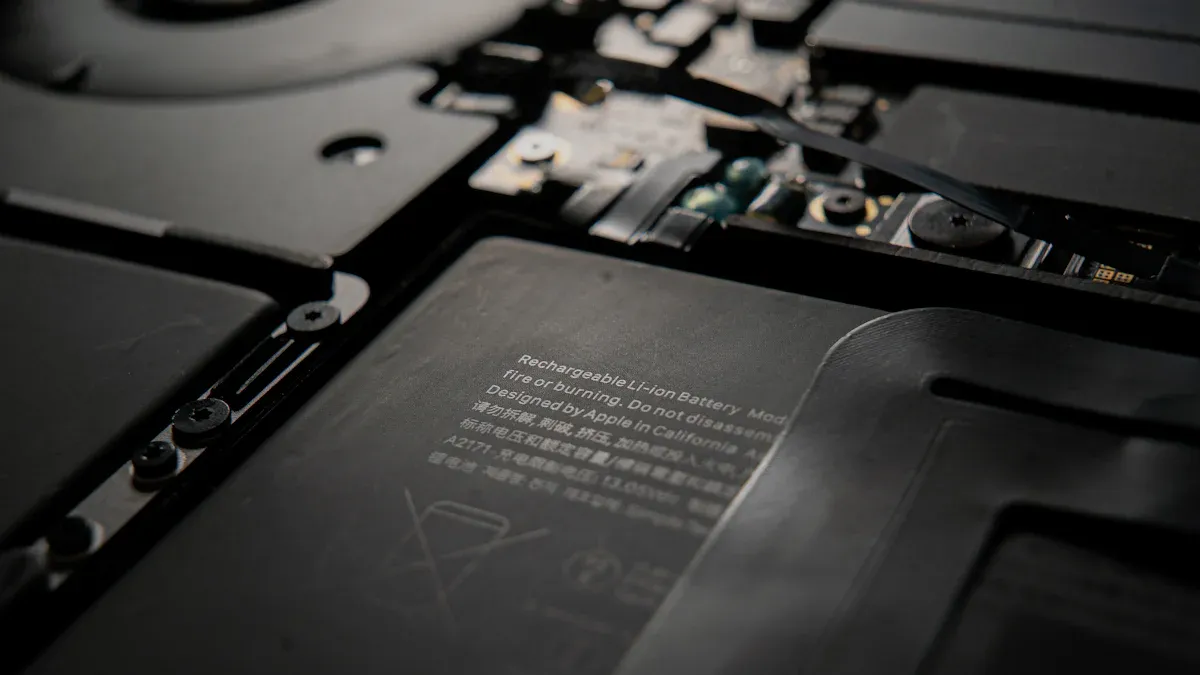
Электромобили
Ternary lithium batteries play a major role in electric vehicles. Many car makers choose these batteries because they offer high energy density, usually between 170 and 250 Wh/kg. This means electric vehicles can travel longer distances on a single charge. These batteries also have a higher voltage platform of 3.7V, which helps increase energy capacity. Drivers in cold regions benefit from ternary lithium batteries because they work well even at temperatures as low as -30°C. The lightweight design allows car makers to build smaller and lighter battery packs.
- High energy density for longer range
- Good low-temperature performance
- Lightweight for better efficiency
- Fast charging speeds for convenience
However, these batteries need strong safety systems. They can lose capacity faster and have lower output efficiency compared to other types. Despite these challenges, ternary lithium batteries are now common in electric vehicles that require high performance and long-distance travel.
Бытовая электроника
Ternary lithium batteries power many high performance electronics, such as smartphones, laptops, and tablets. These batteries provide a balance of energy density, safety, and lifespan. The таблица below shows how they compare to other battery types:
| Тип батареи | Приложения | Плотность энергии | Безопасность | Продолжительность жизни | Стоимость |
|---|---|---|---|---|---|
| Lithium Cobalt Oxide | Smartphones, laptops, tablets | Высокий | Низкий | Средний | Высокий |
| Ternary Lithium (NCM) | Electric vehicles, electronics, tools | Medium to High | Medium to High | Высокий | Переменная |
Ternary lithium batteries often have capacities between 3,001mAh and 5,000mAh, which fits the needs of most portable devices. Their long cycle life and improved safety make them a top choice for high performance applications in consumer electronics.
Energy Storage
Energy storage solutions use ternary lithium batteries to store power from renewable sources like wind and solar. These batteries can hold more energy in less space, making them ideal for grid systems. In Germany, battery storage with wind farms reduced grid instability by 15%. Projects in the UK use these batteries to balance supply and demand. Over the past decade, costs have dropped by 80%, and longer lifespans give better returns on investment. Battery storage also helps lower emissions and supports recycling efforts. Advanced battery management systems improve safety and performance in these large-scale applications.
Other Uses
Ternary lithium batteries serve many other roles outside electric vehicles and consumer electronics. They appear in power tools, industrial equipment, and telecommunications systems. Aerospace and defense sectors use these batteries for their high energy density and reliability. Some companies design special battery chemistries for unique needs in these fields. As technology advances, more industries will use ternary lithium batteries for their high performance and energy storage needs.
Future of Ternary Lithium Batteries
Innovations
Researchers and manufacturers continue to improve ternary lithium batteries. Many new methods help make these batteries safer, longer-lasting, and more powerful. Some of the latest innovations include:
- Advanced synthesis methods, such as sol-gel and co-precipitation, increase material purity and consistency.
- Surface coating and ion doping technologies strengthen the cathode and boost battery safety.
- New electrolyte additives and separator materials help prevent short circuits and improve thermal stability.
- Battery management systems now use real-time monitoring to avoid unsafe conditions and extend cycle life.
- High-nickel cathodes and silicon-based anodes raise energy density and improve cycle life.
- Artificial Intelligence (AI) and Internet of Things (IoT) technologies help optimize battery manufacturing and performance.
- Closed-loop recycling systems and green manufacturing practices reduce the environmental impact of lithium battery production.
- Solid-state battery research aims to make batteries even safer and more energy-dense.
- Industry partnerships and investments, especially from the automotive sector, drive rapid progress.
Many companies also focus on sustainable sourcing and recycling. These efforts help lower costs and protect the environment. As a result, ternary lithium battery technology continues to evolve quickly.
Market Trends
The global market for ternary lithium batteries is growing fast. Demand comes from electric vehicles, energy storage, and many other applications. The table below shows key market data and trends:
| Metric/Region | 2022 Value/Status | Growth/Projection/Notes |
|---|---|---|
| Global lithium-ion battery shipments | 957 GWh | 70% year-on-year increase |
| China’s lithium-ion battery production | 750 GWh | Over 130% year-on-year increase |
| New energy vehicle sales (global) | 10.8 million units | 61.6% year-on-year increase |
| New energy vehicle sales (China) | 6.8 million units | 63.6% global market share |
| New energy vehicle penetration rate (Q4 2022) | China: 27%, Europe: 19%, North America: 6% | Adoption rates rising worldwide |
| New energy vehicle power battery loading | About 295 GWh | Strong demand for ternary lithium batteries |
| Energy storage battery shipments | 159.3 GWh | 140% year-on-year increase |
| Market forecast | Projected growth through 2031 | Market size and revenue expected to rise significantly |
| Market segmentation | By type and application | Diverse and expanding market applications |
Electric vehicles drive much of this growth. China leads in both production and sales. Energy storage systems also use more ternary lithium batteries each year. Experts expect the market to keep expanding as technology improves and more industries adopt these batteries.
Ternary lithium batteries use nickel, cobalt, and manganese to achieve high energy density and strong power output. They work well in electric vehicles and portable electronics but need careful thermal management. The table below compares key features:
| Характеристика | Ternary Lithium (NCM) | LiFePO₄ |
|---|---|---|
| Плотность энергии | 232–293 Wh/kg | ~150 Wh/kg |
| Цикл жизни | 800–1,000 cycles | 2,000–6,000 cycles |
| Безопасность | Умеренный | Высокий |
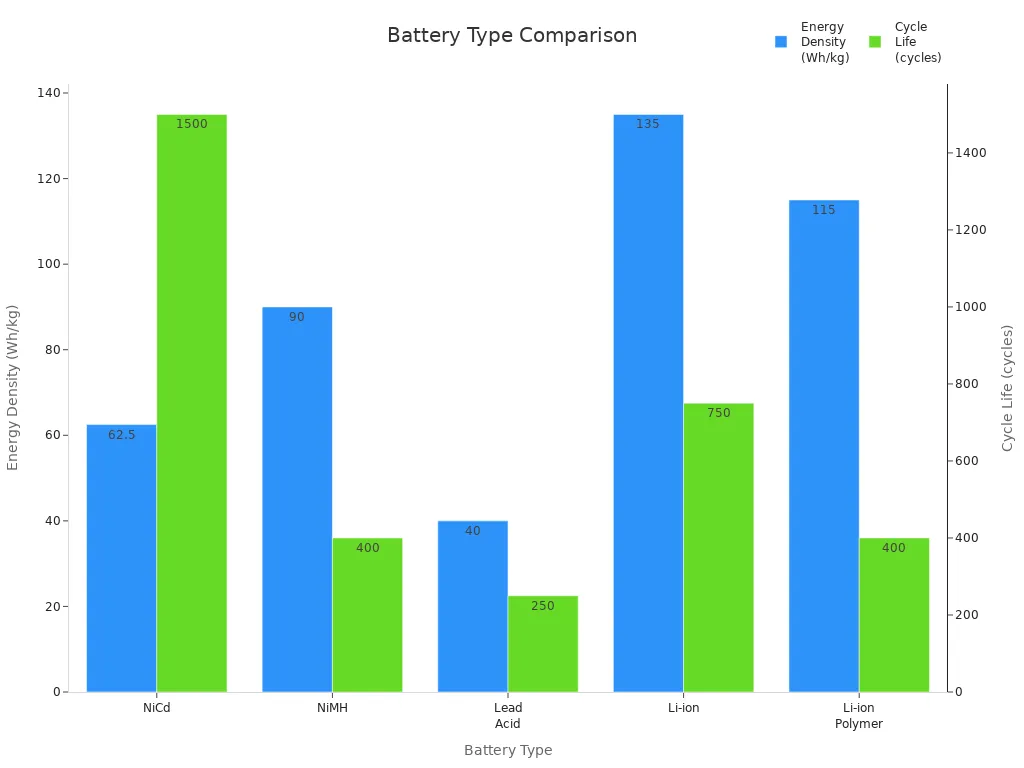
When choosing a battery, users should weigh energy needs, safety, cost, and environmental impact. Future trends include better materials, safer designs, and smarter battery management. Each person should match battery type to their own priorities and application.
ЧАСТО ЗАДАВАЕМЫЕ ВОПРОСЫ
What makes ternary lithium batteries different from other lithium-ion batteries?
Ternary lithium batteries use nickel, cobalt, and manganese in the cathode. This mix gives them higher energy density and better performance than many other lithium-ion batteries. Most other types use only one or two metals.
Are ternary lithium batteries safe to use?
Manufacturers add safety features like battery management systems and strong separators. These features help prevent overheating and short circuits. Users should follow charging and storage guidelines to keep batteries safe.
How long do ternary lithium batteries last?
Most ternary lithium batteries last between 500 and 1,000 charge cycles. Proper care, such as avoiding deep discharges and extreme temperatures, can help extend battery life.
Can ternary lithium batteries be recycled?
Yes, recycling centers can process ternary lithium batteries. They recover valuable metals like nickel, cobalt, and manganese. Recycling helps reduce environmental impact and saves resources.

